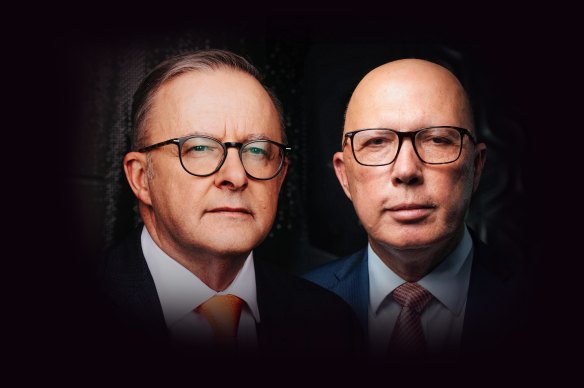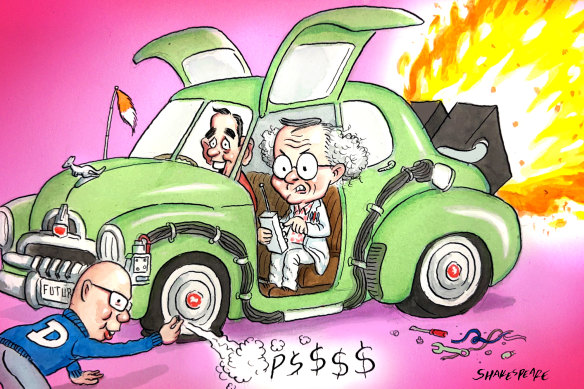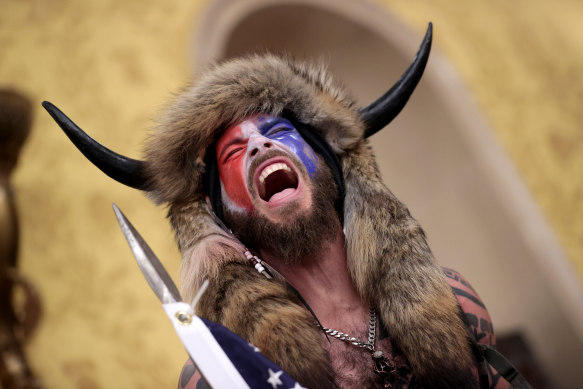This was published 6 months ago
Opinion
Albanese has a vision splendid. Can Dutton the wrecker spoil it?
Peter Hartcher
Political and international editorIt’s one of the most familiar complaints about Australian leaders. They lack vision. “Where’s the vision?” runs the traditional lament.
This week, Anthony Albanese gave us one. The Future Made in Australia plan is taking shape as an ambitious national effort to create new industries.

Prime Minister Anthony Albanese and Opposition Leader Peter Dutton are certain to spar over housing and immigration in coming months.Credit: AFR
Long after we’ve forgotten the $300 power rebate, the tax cuts and other details of this week’s federal budget, we’ll be talking about this startling break with the hands-off economic orthodoxy of the past 40 years. And whether it’s succeeding or failing.
Overwhelmingly, the Future Made in Australia is designed to be a future made outside the big cities, in Australia’s regions and far-flung towns. In the places that most fear the future, Albanese’s vision is to generate hope.
One of the chief reasons that the United States was ready to embrace Donald Trump in 2016 was that post-industrial America had forgotten about the communities who’d built industrial America. The communities of the Rust Belt, the ones in the fly-over zones, the people dismissed by Hillary Clinton as “deplorables”, were left with falling wages, trapped in homes losing value, consoling themselves with opioids.
The American Dream was dead, and many of the people mourning it voted for Trump. Not to fix the system that had failed them, but to destroy it.

Credit: John Shakespeare
Many of Australia’s towns and regions have long suffered shrinking populations, shrivelling opportunity and disappearing hope. It’s nowhere near American levels of despair, but the trajectory looks disturbingly familiar.
Albanese’s Future Made in Australia is intended to “support resource communities, in particular, through the coming period of economic change – town by town, worker by worker”, as he’s said.
As coal mines close and coal-fired power generators shut down over the next 20 years, Albanese wants new investment to flow into the communities left behind. To build new projects in green hydrogen, green steel, green aluminium and critical minerals.
In other words, to pre-empt the sort of situation that Trump has described as “American carnage”. The prime minister is pursuing the Future Made in Australia plan for several key reasons; Trump-proofing the country is one of them.

They voted not to fix the system that had failed them, but to destroy it.
Albanese, for years, has been talking about how to promote manufacturing in Australia. He was encouraged by the experience of the Queensland town of Maryborough: “I did three trips down the Bruce Highway” — the 1700-kilometre artery from Cairns to Brisbane — between 2019 and 2022. “When you hit Maryborough, it’s stark how well it’s going,” Albanese tells me. “Making trains there at Downer EDI has brought other investment and lifted the whole town above the pack.”
Most recently, the company in 2021 won a $7 billion state government contract to build 65 trains to service the forthcoming Brisbane Olympics.
“We can make things; our future economy and our national security demand it,” Albanese says.
Since he first started proselytising about manufacturing, the world has changed dramatically, in a way that favours state-sponsored manufacturing. One big change is that the pandemic delivered a shock. When supply chains faltered, the world realised that it was heavily dependent on China for essential technologies. And that China is racing to monopolise the manufacture of all the vital components of a net zero emissions world economy.
“The US is in a state of near panic about the green industry tidal wave coming out of China,” the Lowy Institute’s China expert, Richard McGregor, observes. “Not just electric vehicles, but batteries and solar panels and all the components and intellectual property embedded in them,” he writes in The Australian Financial Review. This “China shock”, he says, “will give Chinese companies dominance over the industrial revolution of the future”.
Which is why US President Joe Biden created a vast program of government subsidies for green industries. Valued at over half-a-trillion dollars, it goes by the misleading rubric of the Inflation Reduction Act. It’s designed to suck trillions in private capital from around the world into the US. And because it showed signs of doing exactly that, other rich democracies have entered the competition – the European Union, Japan, South Korea and Canada have all created big government subsidy and support programs of their own.
“Obviously, Australia cannot go dollar for dollar with the US Inflation Reduction Act,” Albanese said in a recent speech. “But this is not an auction – it’s a competition.”
Australia can benefit from this global competition if it plays to its comparative advantage, the government argues – the world’s cheapest renewable energy, vast land mass, enormous deposits of just about every rare earth and critical mineral essential to the net zero economy, plus technical expertise in mining and renewables. One of Treasurer Jim Chalmers’ favourite lines is that Australia can be a “beneficiary not a victim” of this investment boom.
How big is this boom? The International Energy Agency estimates that $US200 trillion (about $300 trillion) will be invested worldwide in creating the net zero economy over the next three decades. That’s equivalent to twice the total world GDP this year.
But the sort of manufacturing to be supported by this week’s budget announcement is very different to train-making. Chalmers announced $22.7 billion worth of tax credits for companies producing green hydrogen and for refining and processing critical minerals, effective in 2027. This is by far the biggest part of the Future Made in Australia policy that we’ve so far seen. What’s the plan?
At the moment, in a carbon-fuelled world, Australia ships massive volumes of rocks abroad to be smelted into iron and other metals. But in a world of zero emissions, the economics flip – it becomes much cheaper to smelt the rocks here, using green hydrogen as the power supply, and then export the green metals that are produced. This was first identified years ago as Australia’s renewables “superpower” opportunity by the eminent economist Ross Garnaut.
But that’s only half the story. The second big change is the growing conviction that the world is heading for a major crisis. The fast-frosting cold war between the US and its allies on the one hand and China and Russia on the other has created fears that it could one day turn hot, that countries will need independent supplies of essential goods as world shipping is interrupted by embargo or war.
And it’s this fear that explains other parts of Albanese’s Future Made in Australia – $1 billion to make solar panels in Australia, for example. Not because there’s a shortage of solar panels today but because Australia does not want to be dependent on China in the event that supply is cut off tomorrow.
But Albanese wasn’t counting on Peter Dutton. The opposition leader immediately announced that the Coalition would block the tax credits at the centre of the plan.
Labor’s policy is called “Future Made in Australia” because it’s a catchy motto that tested well in focus groups. Now Dutton produced his counter-motto. Labor’s plan, he said, would give “billions to billionaires”. Companies controlled by mining magnates such as Gina Rinehart and Andrew Forrest, for example, would be beneficiaries.
It’s a catchy counter; it also has the potential to destroy the Future Made in Australia before it’s had a chance to begin. If the Coalition pledges to repeal the tax credits, companies will be reluctant to invest in setting up big processing facilities lest the promised tax credits evaporate. The vision will remain just that.
But the argument isn’t over. Dutton was too hasty for his Liberal colleagues in Queensland and Western Australia – the LNP and Liberal parties in those states have strongly endorsed the Albanese plan. Further, Dutton’s Coalition partners, the Nationals, happen to think it’s a good idea to subsidise the processing and refining of critical minerals.
Only in 2021, the Morrison government announced it was “establishing a $2 billion Critical Minerals Investment Fund to help develop Australia’s capability to produce these vital resources for global supply chains”. And another $200 million for a Critical Minerals Accelerator Initiative.
These commitments were wrung out of Morrison by the Nationals. These support mechanisms are different to the production tax credits proposed by Albanese, but they are subsidies nonetheless.
What’s Dutton planning to do about those promises, which weren’t delivered by the time the Coalition lost office?
The Nationals’ leader in the Senate, Bridget McKenzie, knows what her party wants. “I am confident any future Coalition government would continue that investment,” she tells me, “so that regions could be prosperous and secure in a net zero emission future.” Dutton faces pressure from the states and the Nationals to moderate his emphatic “no”.
Albanese’s vision of a Future Made in Australia will first need legislation made in parliament. We’ll see how it goes, but it’s not customarily the venue for a vision splendid.
Peter Hartcher is political editor.
The best of Good Weekend delivered to your inbox every Saturday morning. Sign up here.